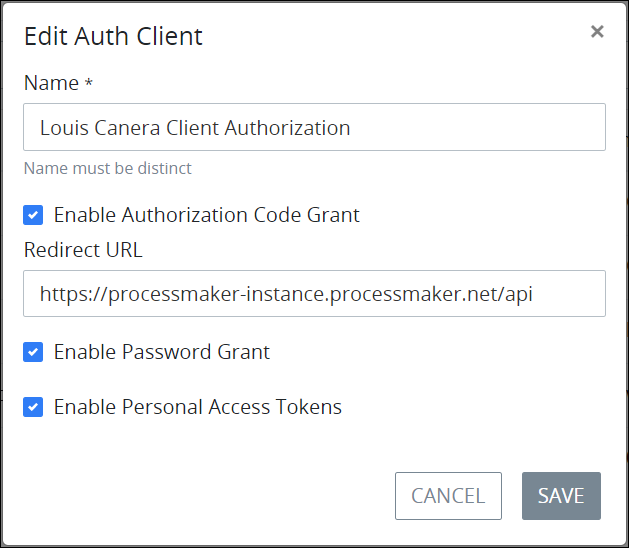Edit an authenticated client.
Edit an Authenticated Client
Permissions
Your user account or group membership must have the following permissions to edit client authentication unless your user account has the Make this user a Super Admin setting selected:
Auth Clients: Edit Auth Clients
Auth Clients: View Auth Clients
See the Auth Clients permissions or ask your Administrator for assistance.
Follow these steps to edit authenticated client information that allows that application to access our RESTful API in your instance:
View all authenticated clients. The Auth Clients page displays.
Click the
 menu, and then select the Edit Auth Client option for the authenticated client to edit. The Edit Auth Client screen displays.
menu, and then select the Edit Auth Client option for the authenticated client to edit. The Edit Auth Client screen displays. 
Edit Auth Client screen to edit an authenticated client In the Name setting, enter to whom the authenticated client application is granted. This name must be unique from all other authenticated clients. This is a required setting.
Edit any of the following options as necessary to indicate at least one method by which the client application is granted access to your RESTful API:
Enable Authorization Code Grant: Select the Enable Authorization Code Grant checkbox to display the Redirect URL setting in this screen to enter the URI or URL where to send the authorized application after it is granted an access token to your API. If this checkbox is not selected, the Redirect URL setting is hidden and that client application cannot access your instance via a redirected URL.
Enable Password Grant: Select the Enable Password Grant checkbox to authenticate legacy desktop applications which directly send a username and password to receive an access token to your API. If ProcessMaker Platform as the authorization server recognizes these credentials, the authorization server returns an access token to the client application. This authorization method is not as secure because it does not require a callback, so it is not best practice to use this authorization method unless granting the access token to a legacy desktop application.
Enable Personal Access Tokens: Select the Enable Personal Access Tokens checkbox to use a personal access token (PAT) as an alternate password to authenticate the client application into your environment if that application supports its use. The third-party application developer is responsible for creating the PAT.
Click Save.